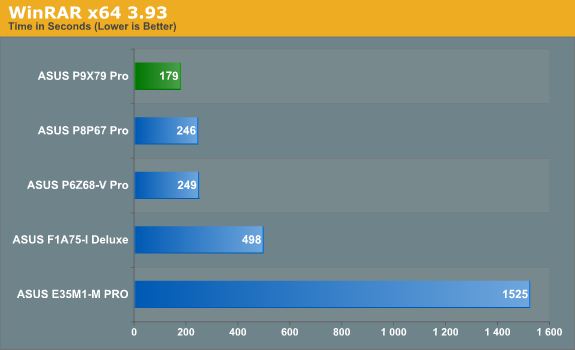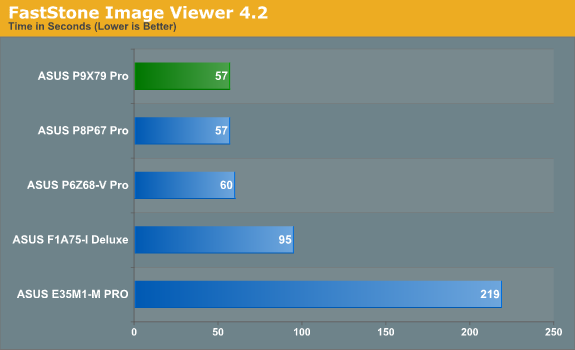Sandy Bridge-E and X79 – The ASUS P9X79 PRO Review
by Ian Cutress on November 14, 2011 3:01 AM EST- Posted in
- Motherboards
- Asus
- X79
3D Movement Algorithm Test
The algorithms in 3DPM employ both uniform random number generation or normal distribution random number generation, and vary in various amounts of trigonometric operations, conditional statements, generation and rejection, fused operations, etc. The benchmark runs through six algorithms for a specified number of particles and steps, and calculates the speed of each algorithm, then sums them all for a final score. This is an example of a real world situation that a computational scientist may find themselves in, rather than a pure synthetic benchmark. The benchmark is also parallel between particles simulated, and we test the single thread performance as well as the multi-threaded performance.


As expected, due to the 3960X, we have a clear lead on 3DPM. In single thread mode, we have a 3.9 GHz core taking top place, and the power of 12 threads at 3.6 GHz in multithreaded mode shows in the 914.76 score.
WinRAR x64 3.93 - link
With 64-bit WinRAR, we compress the set of files used in the USB speed tests. WinRAR x64 3.93 attempts to use multithreading when possible.

The more cores and threads for WinRar also play a role in providing some excellent times in comparison to other chipsets.
FastStone Image Viewer 4.2 - link
FastStone Image Viewer is a free piece of software I have been using for quite a few years now. It allows quick viewing of flat images, as well as resizing, changing color depth, adding simple text or simple filters. It also has a bulk image conversion tool, which we use here. The software currently operates only in single-thread mode, which should change in later versions of the software. For this test, we convert a series of 170 files, of various resolutions, dimensions and types (of a total size of 163MB), all to the .gif format of 640x480 dimensions.

In this single threaded workload, no real difference is seen compared to P67, showing that for FastStone, memory is not a limiting factor, and the move to SB-E doesn't make much of a difference.
Sorenson Squeeze 6.0 - link
Sorenson Squeeze is a professional video encoder, complete with a vast array of options. For this test, we convert 32 HD videos, each a minute long and approximately 42 MB in size, to WMV 512KBps format. Squeeze can encode multiple videos at once, one for each thread.

With Squeeze being a fully multithreaded test, we're comparing a 4 thread i5-2500K to a 12 thread 3960X, so it's no wonder that the 3960X comes out on top.










55 Comments
View All Comments
ASUSTechMKT - Wednesday, November 16, 2011 - link
No problem i will look into it and let you know.bradcollins - Wednesday, November 16, 2011 - link
I've bought the Asus P9X79 Deluxe board now and it works perfectly. I can force the multiplier up to the 33x max of the cpu but no matter what settings I try, I can not get the 1.25x multiplier to work, the board does not post after setting it to 1.25 or 1.66. Even with the multiplier set to 20x. I updated the bios to the new version on your site and it hasn't made a difference.Can you get the right person to email me at otama@ihug.co.nz? Maybe an update needs to be made to support Xeons at 1.25x or 1.66x base clock?
Other than that, the board is brilliant :)
ASUSTechMKT - Saturday, November 26, 2011 - link
This is not a UEFI limitation or bug the Xeon CPUs do not support strap changes.
msroadkill612 - Tuesday, November 15, 2011 - link
am i missing something - why would an enthusiast give up 1/3 of the silicon for crap intel graphics - wouldnt they go an I7 & discrete gpuSB just doesnt make sense to me - the mainstream market it targets can live w/ a slower cpu but must have decent graphics. Ignorance aside, they want a lot more for a lot less.
when this hits the shelves in quantity - llano mobos & apuS will be mature, cheap & better - my pick anyday.
jecs - Tuesday, November 15, 2011 - link
I upgraded to SB 2600k/ASUS MOBO/Quadro from day one this year and I am not ready to upgrade again maybe until next year. But as I use this machine for 3D modeling/rendering almost exclusively I am interested in a Xeon class workstation as my next machine. With this SB-E platform I wonder if this is a new class of entry Xeon workstation. But what are the advantages and disadvantages? I mean isn't it overlapping with single socket Xeon workstations? Fortunately I can wait until next year to compare side by side what I will get from each. I can think on ECC memory on a Xeon, but what else?SSD catching on a workstation machine will be solved with at least an 128 SSD for the system and important applications, so I see no real problem there. USB3 could be a problem next year as more devices may be available. So I can see some confusion in what really is this platform target if the price in the same as a Xeon workstation.
Please Anand I would like to see a system to system comparison in the future.
RegGam - Tuesday, November 15, 2011 - link
"Please Anand I would like to see a system to system comparison in the future."Yes! Spec reviews and pictures are nice and all, but real system to system comparisons for different workloads would be hella more useful. And, when you do so, please enable the max feature set that one system is capable of.
For example, enabling the use of the differentiating features like RAM cache during your benchmarks would give readers a good idea of how ASUS' system outperforms (or not) Gigabyte's board. Also, soup it up with ASUS SSD cache and overclock.
abeeftec - Friday, November 18, 2011 - link
"The XMP profile was easy enough to enable with the XMP mode. For more performance, I pushed the board on to the 2400 MHz strap, which booted at auto values of 10-11-10 2T, and was completely stable. Moving towards the 2666 MHz strap caused failed boots. The nearest strap while on the 1.25x ratio was only at 2333 MHz, suggesting that 2400 MHz on the 1.00x strap is a safe memory overclock. "What? 1600Mhz Memory overclocked to 2400Mhz?
Also, I have a Gigabyte Assassin board and the Strap appears to coincide with the Bclk and PCIe. Not memory!
So any upping the gear ratio over 1.00x causes Boot failure.
Does anyone know if the K series is the cause of this. What I mean is, Does the 3930K strap the Bclk/PCIe and the X series Straps the Bclk/ Memory? Not having purchased the 3960X causes a bit of confusion because this area on my board is all Bclk/PCIe related.
Bclk/PCie Clock Control - Manual
Host Clock Frequency - 100.00Mhz
Processor Base Clock (Gear Ratio)- 1.00x
Bclk/PCie Clock Evaluation-100.00Mhz
Changing the Processor Base clock(Gear Ratio) to 1.25x Changes the Bclk/PCIe Clock Evaluation to- 125.00Mhz which causes a 3930K CPU to change to a Frequency of 4.0Ghz from 3.2Ghz with a Multiplier of 32.
My confusion is that Anand said that one touch OC overclocks this way. And that he was able to boot using the 1.25x Gear Ratio and that it has to do with Memory! Well you can clearly see by my board layout that it doesnt have anything to do with Memory.
ASUSTechMKT - Saturday, November 26, 2011 - link
CPU Strap adjustment ( BCLK ) does affect memory dividers. While you have a GB board for more information check out our OC guide which details information on how the strap affect dram scaling and the dividers that are present.
CPU has 4 straps: 100, 125, 167, 250: 1:1, 1:1.25, 1:1.67, 1:2.5 respectively
When you select 125MHz BCLK with 125 strap, 125mhz is given to cpu and internally it gives it’s own PCIE/DMI Controller 125 / 1.25 = 100MHz.
When you select 129MHz BCLK with 125 strap, 129mhz is given to cpu and internally it gives it’s own PCIE/DMI Controller 129 / 1.25 = 103.2MHz.
When you select 122MHz BCLK with 125 strap, 122mhz is given to cpu and internally it gives it’s own PCIE/DMI Controller 122 / 1.25 = 97.6MHz.
In regards to the memory divider if you look at the memory dividers applied ( once the board has reposted with the new strap you will see your dividers are different.
In regards to the K part it works exactly the same way.
markgerazzi - Saturday, November 19, 2011 - link
I'm having a hard time deciding between this and the GA X79 UD5The machine I'm having will be running the 3930k processor, with 32gigs of ram for audio production.
Strongpoints:
Asus:
-Better soundcard apparently, which may not matter in the long run
-Better fan control
-More USB 3.0
Gigabyte:
-Great OC button right on the mobo for when I wan't to switch things off before booting up
-3D bios
Other than those things everytthing looks to be the same...
Any pointers?
Thanks!
ASUSTechMKT - Saturday, November 26, 2011 - link
We offer the TPU switch ( which offers an actual higher default quick OC option ) this can be executed directly on the board, in the UEFI or within windows so flexibility is superior for whenever you feel you want to execute this OC.How is the 3D UEFI superior? Their range of adjustments are considerbly reduced compared to our UEFI and in regards to recovery options like our USB Bios Flash back they do not offer anything. If you really take a look at the small features and big features I feel our baords offer superior value plus I do n ot see GB providing feedback. I welcome any questions you may have.
Additionally keep in mind that in the first year of ownership our warranty does offer APS service ( advanced replacement ) meaning if you did have an RMA we would provide a board before you sent in your faulty board.